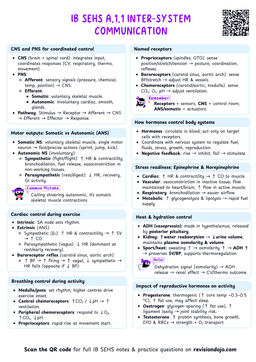The Role of the Cardiovascular System
- The cardiovascular system, also known as the circulatory system, is responsible for the continuous circulation of blood throughout the body.
- It delivers essential substances such as oxygen, nutrients, and hormones while removing metabolic waste.
Functions of the Cardiovascular System in Transport
Transport of Nutrients
Hepatic portal vein
The vein that carries absorbed nutrients from the small intestine to the liver for processing.
- After digestion, nutrients like glucose, amino acids, and fatty acids are absorbed in the small intestine and enter the hepatic portal vein, which carries them to the liver for processing.
- The liver regulates the distribution of these nutrients into the bloodstream for cellular use.
- Glucose is transported via the blood to cells for ATP production through cellular respiration.
- Amino acids are used for protein synthesis, and fatty acids are utilized for energy storage or cell membrane formation.
Think of the bloodstream as a delivery truck carrying raw materials (nutrients) from a factory (digestive system) to various construction sites (cells) where they are used for building and energy production.
ExampleAfter eating a carbohydrate-rich meal, glucose levels in the blood rise, triggering the release of insulin, which helps transport glucose into cells for energy storage.
Transport of Hormones
- The endocrine system releases hormones into the bloodstream to regulate body functions.
- Hormones are chemical messengers that bind to specific receptors on target organs.
Examples of hormones transported via the bloodstream
- Insulin: Secreted by the pancreas to regulate blood sugar levels.
- Adrenaline (epinephrine): Released by the adrenal glands in response to stress, increasing heart rate and blood flow.
- Thyroxine (T4): Produced by the thyroid gland, regulating metabolism and body temperature.
Gas Exchange
Gas exchange
Gas exchange refers to the movement of oxygen into the bloodstream at the lungs and carbon dioxide out of the bloodstream for exhalation.
- Oxygen (O₂) is inhaled into the lungs, where it diffuses into capillaries surrounding the alveoli.
- O₂ binds to hemoglobin (Hb) in red blood cells and is transported to body tissues.
- In tissues, O₂ is released from hemoglobin and diffuses into cells for aerobic respiration, producing ATP.
- Carbon dioxide (CO₂), a waste product of metabolism, diffuses out of cells into the bloodstream:
- 7-10% dissolves in plasma.
- 20% binds to hemoglobin (as carbaminohemoglobin).
- 70% is converted into bicarbonate ions (HCO₃⁻) for transport.
- CO₂ is expelled through the lungs during exhalation.
Bicarbonate ions
The primary form of carbon dioxide transport in the blood, formed when CO₂ combines with water.
During intense exercise, muscles consume more oxygen and produce more CO₂, triggering an increased breathing rate and heart rate to maintain gas balance.

Heat Distribution and Thermoregulation
Blood plays a key role in maintaining homeostasis by redistributing heat.
Vasodilation
The widening of blood vessels to increase blood flow and promote heat loss.
Vasoconstriction
The narrowing of blood vessels, directing blood to vital organs during stress or physical exertion.
- Vasodilation (Heat Loss): Blood vessels widen, increasing blood flow to the skin to release excess heat (e.g., sweating).
- Vasoconstriction (Heat Retention): Blood vessels narrow, reducing heat loss by redirecting blood to vital organs (e.g., in cold environments).
After running in hot weather, the body redirects blood to the skin, causing flushing (red skin) as blood vessels expand to cool the body.
Waste Removal
- Carbon dioxide is transported via blood and expelled through the lungs.
- Urea, a waste product of protein metabolism, is filtered out by the kidneys and excreted in urine.
- Lactic acid, produced during anaerobic respiration, is carried to the liver for breakdown into glucose via the Cori cycle.
Components of the Cardiovascular System in Transport
| Component | Function |
|---|---|
| Heart | A muscular organ that pumps blood throughout the body, maintaining circulation. |
| Blood Vessels | Includes arteries, veins, and capillaries that serve as the transport network for blood. |
| Blood | Components of the Cardiovascular System in Transport |
Imagine the cardiovascular system as a delivery network:
- The heart is the central hub (distribution center).
- Blood vessels are the roads and highways.
- Blood acts as the delivery trucks carrying supplies (oxygen, nutrients, hormones).
- Cells are the customers receiving deliveries.

Variability in Cardiovascular Responses
- The cardiovascular system adapts dynamically to maintain oxygen delivery, nutrient transport, and waste removal based on physiological demands.
- Heart rate (HR), stroke volume (SV), cardiac output (Q), blood pressure (BP), and blood redistribution vary due to several factors, such as:
- Age
- Sex differences
- Body size
- Fitness level
- Type and intensity of physical activity
Key Cardiovascular Variables
Heart Rate (HR)
Heart rate
Heart rate is the number of times the heart beats per minute (bpm). It reflects how fast the heart pumps blood to meet metabolic demands.
- Resting HR: 60–80 bpm (lower in trained individuals).
- Exercise HR: Can rise up to 200 bpm in intense activity.
- Recovery HR: Returns to normal post-exercise (faster recovery = better fitness).
Endurance athletes like marathon runners have a low resting heart rate (~40 bpm) due to better cardiovascular efficiency.
Factors Influencing HR
- Age: Maximal heart rate decreases with age.
- Sex: Females tend to have a higher resting heart rate compared to males.
- Fitness level: Athletes usually have a lower resting heart rate due to higher stroke volume and efficiency.
- Activity type and intensity: High-intensity activities cause a rapid increase in HR.
Maximal Heart Rate (HRmax) = 220 – Age (useful for estimating exercise intensity zones).
Stroke Volume (SV)
Stroke volume
Stroke volume (SV) is the amount of blood ejected from the left ventricle per beat (mL/beat).
- At rest, SV is around 70 mL per beat.
- During exercise, SV can increase to 100–120 mL per beat.


